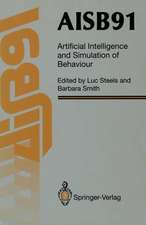Embodied Artificial Intelligence: International Seminar, Dagstuhl Castle, Germany, July 7-11, 2003, Revised Selected Papers: Lecture Notes in Computer Science, cartea 3139
Editat de Fumiya Iida, Rolf Pfeifer, Luc Steels, Yasuo Kuniyoshien Limba Engleză Paperback – 8 iul 2004
Following an introductory overview, the 23 papers are organized into topical sections on
- philosophical and conceptual issues
- information, dynamics, and morphology
- principles of embodiment for real-world applications
- developmental approaches
- artificial evolution and self-reconfiguration
Din seria Lecture Notes in Computer Science
- 20%
 Preț: 1061.55 lei
Preț: 1061.55 lei - 20%
 Preț: 307.71 lei
Preț: 307.71 lei - 20%
 Preț: 438.69 lei
Preț: 438.69 lei - 20%
 Preț: 645.28 lei
Preț: 645.28 lei -
 Preț: 410.88 lei
Preț: 410.88 lei - 15%
 Preț: 580.46 lei
Preț: 580.46 lei - 17%
 Preț: 427.22 lei
Preț: 427.22 lei - 20%
 Preț: 596.46 lei
Preț: 596.46 lei -
 Preț: 381.21 lei
Preț: 381.21 lei - 20%
 Preț: 353.50 lei
Preț: 353.50 lei - 20%
 Preț: 1414.79 lei
Preț: 1414.79 lei - 20%
 Preț: 309.90 lei
Preț: 309.90 lei - 20%
 Preț: 583.40 lei
Preț: 583.40 lei - 20%
 Preț: 1075.26 lei
Preț: 1075.26 lei - 20%
 Preț: 310.26 lei
Preț: 310.26 lei - 20%
 Preț: 655.02 lei
Preț: 655.02 lei - 20%
 Preț: 580.93 lei
Preț: 580.93 lei - 20%
 Preț: 340.32 lei
Preț: 340.32 lei - 15%
 Preț: 438.59 lei
Preț: 438.59 lei - 20%
 Preț: 591.51 lei
Preț: 591.51 lei - 20%
 Preț: 649.49 lei
Preț: 649.49 lei - 20%
 Preț: 337.00 lei
Preț: 337.00 lei -
 Preț: 449.57 lei
Preț: 449.57 lei - 20%
 Preț: 607.39 lei
Preț: 607.39 lei - 20%
 Preț: 1024.44 lei
Preț: 1024.44 lei - 20%
 Preț: 579.30 lei
Preț: 579.30 lei - 20%
 Preț: 763.23 lei
Preț: 763.23 lei - 20%
 Preț: 453.32 lei
Preț: 453.32 lei - 20%
 Preț: 575.48 lei
Preț: 575.48 lei - 20%
 Preț: 585.88 lei
Preț: 585.88 lei - 20%
 Preț: 825.93 lei
Preț: 825.93 lei - 20%
 Preț: 763.23 lei
Preț: 763.23 lei - 17%
 Preț: 360.19 lei
Preț: 360.19 lei - 20%
 Preț: 1183.14 lei
Preț: 1183.14 lei - 20%
 Preț: 340.32 lei
Preț: 340.32 lei - 20%
 Preț: 504.57 lei
Preț: 504.57 lei - 20%
 Preț: 369.12 lei
Preț: 369.12 lei - 20%
 Preț: 583.40 lei
Preț: 583.40 lei - 20%
 Preț: 343.62 lei
Preț: 343.62 lei - 20%
 Preț: 350.21 lei
Preț: 350.21 lei - 20%
 Preț: 764.89 lei
Preț: 764.89 lei - 20%
 Preț: 583.40 lei
Preț: 583.40 lei -
 Preț: 389.48 lei
Preț: 389.48 lei - 20%
 Preț: 341.95 lei
Preț: 341.95 lei - 20%
 Preț: 238.01 lei
Preț: 238.01 lei - 20%
 Preț: 538.29 lei
Preț: 538.29 lei
Preț: 346.56 lei
Preț vechi: 433.21 lei
-20% Nou
Puncte Express: 520
Preț estimativ în valută:
66.32€ • 69.41$ • 55.19£
66.32€ • 69.41$ • 55.19£
Carte tipărită la comandă
Livrare economică 31 martie-14 aprilie
Preluare comenzi: 021 569.72.76
Specificații
ISBN-13: 9783540224846
ISBN-10: 354022484X
Pagini: 344
Ilustrații: X, 334 p.
Dimensiuni: 155 x 233 x 18 mm
Greutate: 0.81 kg
Ediția:2004
Editura: Springer Berlin, Heidelberg
Colecția Springer
Seriile Lecture Notes in Computer Science, Lecture Notes in Artificial Intelligence
Locul publicării:Berlin, Heidelberg, Germany
ISBN-10: 354022484X
Pagini: 344
Ilustrații: X, 334 p.
Dimensiuni: 155 x 233 x 18 mm
Greutate: 0.81 kg
Ediția:2004
Editura: Springer Berlin, Heidelberg
Colecția Springer
Seriile Lecture Notes in Computer Science, Lecture Notes in Artificial Intelligence
Locul publicării:Berlin, Heidelberg, Germany
Public țintă
ResearchCuprins
Philosophical and Conceptual Issues.- Embodied Artificial Intelligence: Trends and Challenges.- Embodied AI as Science: Models of Embodied Cognition, Embodied Models of Cognition, or Both?.- The Future of Embodied Artificial Intelligence: Machine Consciousness?.- Do Real Numbers Really Move? Language, Thought, and Gesture: The Embodied Cognitive Foundations of Mathematics.- Information, Dynamics, Morphology.- Information-Theoretical Aspects of Embodied Artificial Intelligence.- Robot Bouncing: On the Synergy Between Neural and Body-Environment Dynamics.- The Need to Adapt and Its Implications for Embodiment.- How Should Control and Body Systems Be Coupled? A Robotic Case Study.- Self-Stabilization and Behavioral Diversity of Embodied Adaptive Locomotion.- Principles of Embodiment for Real-World Applications.- Removing Some ‘A’ from AI: Embodied Cultured Networks.- Mutual Adaptation in a Prosthetics Application.- A Human-Like Robot Hand and Arm with Fluidic Muscles: Biologically Inspired Construction and Functionality.- Agent-Environment Interaction in Visual Homing.- Bayesian Modeling and Reasoning for Real World Robotics: Basics and Examples.- Developmental Approaches.- From Humanoid Embodiment to Theory of Mind.- Robot Finger Design for Developmental Tactile Interaction.- The Autotelic Principle.- Toward a Cognitive System Algebra: Application to Facial Expression Learning and Imitation.- Maximizing Learning Progress: An Internal Reward System for Development.- You Did It on Purpose! Towards Intentional Embodied Agents.- Towards Imitation Learning from a Viewpoint of an Internal Observer.- Artificial Evolution and Self-Reconfiguration.- On Evolutionary Design, Embodiment, and Artificial Regulatory Networks.- Evolution of Embodied Intelligence.- Self-ReconfigurableRobots: Platforms for Emerging Functionality.
Caracteristici
Includes supplementary material: sn.pub/extras























